

One of the most widely adapted rain lilies in the South, this late summer/fall bloomer quickly clumps into impressive clusters of white star-shaped flowers. White rain lilies have white star shaped blooms that bloom multiple times as summer gives way to fall, and the blooms coincide with schoolhouse lilies (aka oxblood lilies and available here). This lovely lily multiplies rapidly and will brighten your garden at a time when most blooms are wilting in the heat. They thrive in full summer sun, but they do very well in partial shade also. They grow up to a foot tall, and the blooms appear to be sitting on a sea of green grass. Like the rest of their family, the white rain lilies bloom a few days after a summer shower. They have been known to perform well under irrigation as well.
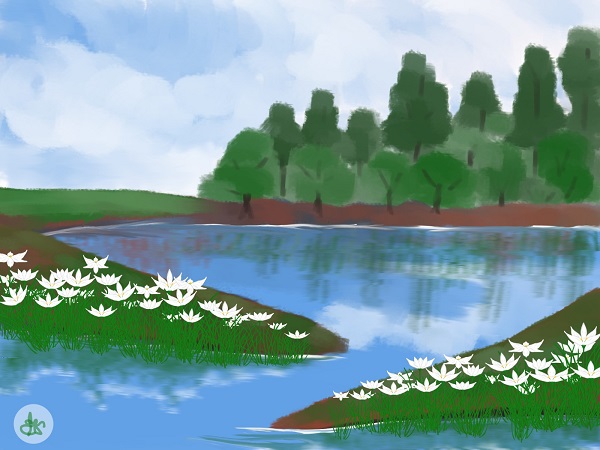
Where to plant: These amazing versatile lilies can be planted anywhere from containers to rock gardens to water gardens. They prefer wet feet which makes them a great addition to those lower-lying areas that stay damp after a hard rain. The white rain lily does well even if it is in standing water for several days. They look amazing when planted along pathways or garden borders. Extremely dry soils will cause it to eventually decline so be sure to water if it is a dry summer. Do you have somewhere that stays boggy? Do you have a pot you have trouble keeping watered and you'd like to fill a pot with no holes once a week, rather than daily watering of well drained pots? Do you have a pond, and you'd like to plant a bulb along the edges that are dry in the summer but covered with water in the spring? Then this rain lily is for you.
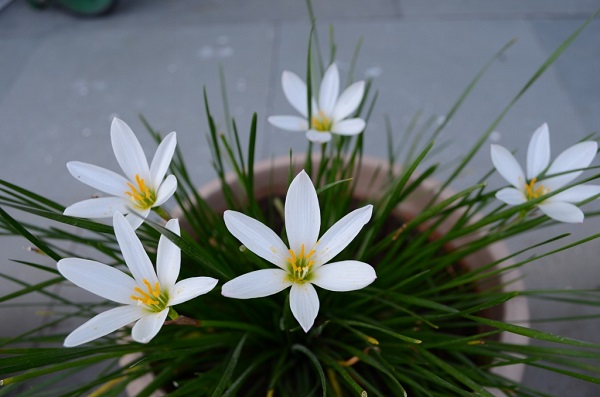
Color and Foliage: The foliage is a lovely dark green, and has a rigid formality as the almost rush-like leaves tend upwards. This is in contrast to a flatter, greyish green foliage that tends to lay down in other rain lilies. Life appears thriving and perky in this little perennial flower. This rain lily is often overlooked as an amazing addition to the garden because people think that it is "simply white" and not eye-catching. Don't get us wrong. We love the pop of color that the Zephyranthes grandiflora and Z. citrina (the pink and yellow rain lilies) give us. By itself, the white rain lily puts on an impressive late summer show. Its clean lines and simplicity can also be used to help draw one's attention to something else that you want to showcase. Can you think of anything in your garden that wouldn't look great next to dark green foliage and white flowers?
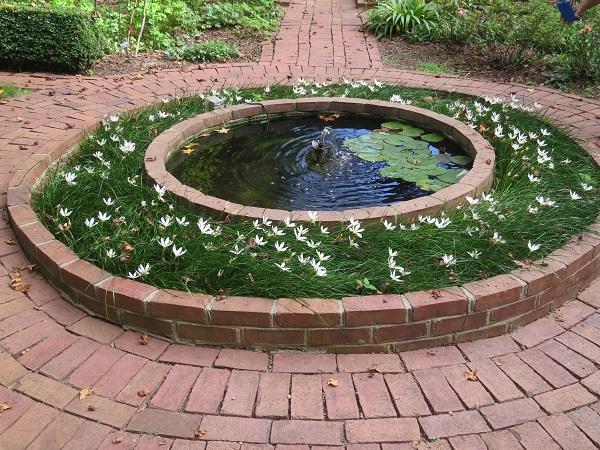
How and when to plant: Plant now (or really any time that isn't a major freeze). It is August, and that means it is HOT here in Texas and most places! On top of the heat, we have had very little rain this summer and last. We have been watering our white rain lilies though and a few are showing their appreciation by giving us some blooms. Other summer flowers are almost completely spent by now, but this beauty is just beginning to show what she is made of. The foliage is a lovely dark green, and this little perennial flower is perky and thriving. The white rain lily looks delicate, but she is durable and hardy. Our white rain lily pots have been in full sun to partial shade in our 100+ degree temperatures all summer long. The bulbs have been multiplying and many of our pots are bursting at the seams.

Dormancy occurs at the first hard frost of winter. They will begin growing again next spring, and a second dormancy occurs if they get hot and dry in the summer. Then, with later summer showers and falling temperatures, the foliage will again flush out and have a growing season with their fall blooms.
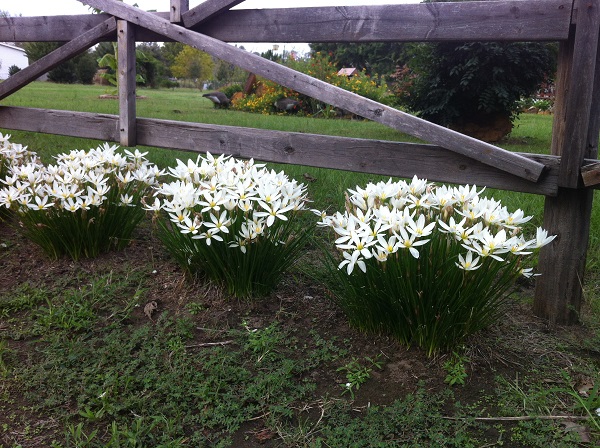
Will they bloom? Everyone wants to know if the bulbs will produce flowers the first year. That's hard to answer because the answer is possibly, maybe, it depends. It depends on how late in the season you are planting them. Perennial bulbs take a while to get established. It depends on how much you pamper them. Do you water them every day trying to help them get adjusted to their new home or do you just wait for the rain? Flower bulbs are tough and will recover after planting. The important thing is that you are planting these perennials to perform well for next season. The foliage is the most important because the longer the bulb has to get established and have foliage, the better the blooms will be for the following year. It takes a lot of energy to produce blooms, and the more nutrients the bulb can store up from the season before the nicer the blooms.
Some people like to see how colors look together or different landscaping ideas so we have included a few extra pictures to showcase how you can use the white rain lily.

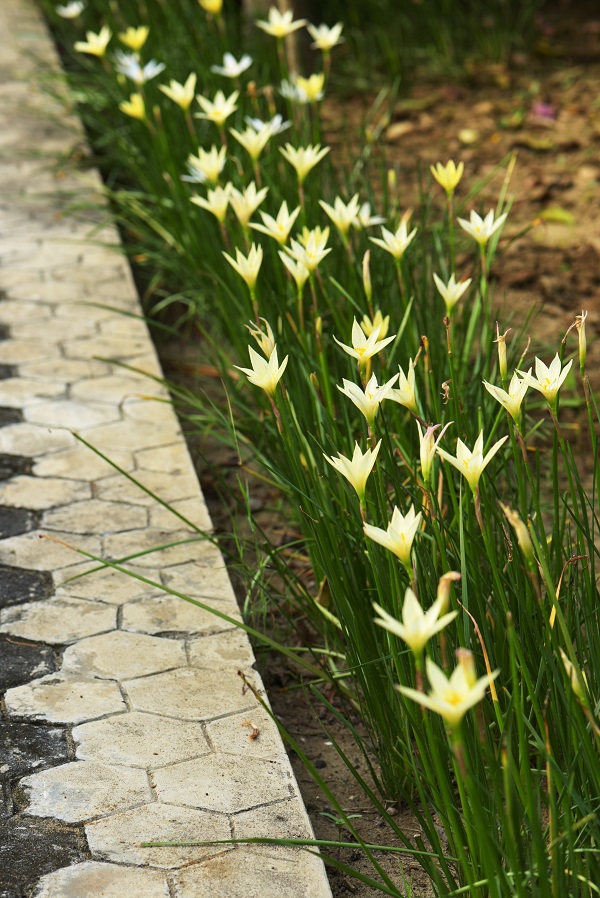
Perennial gardeners are always looking ahead. Remember you're planting a story, and these bulbs are for a lifetime!

One of the most widely adapted rain lilies in the South, this late summer/fall bloomer quickly clumps into impressive clusters of white star-shaped flowers. White rain lilies have white star shaped blooms that bloom multiple times as summer gives way to fall, and the blooms coincide with schoolhouse lilies (aka oxblood lilies and available here). This lovely lily multiplies rapidly and will brighten your garden at a time when most blooms are wilting in the heat. They thrive in full summer sun, but they do very well in partial shade also. They grow up to a foot tall, and the blooms appear to be sitting on a sea of green grass. Like the rest of their family, the white rain lilies bloom a few days after a summer shower. They have been known to perform well under irrigation as well.

Where to plant: These amazing versatile lilies can be planted anywhere from containers to rock gardens to water gardens. They prefer wet feet which makes them a great addition to those lower-lying areas that stay damp after a hard rain. The white rain lily does well even if it is in standing water for several days. They look amazing when planted along pathways or garden borders. Extremely dry soils will cause it to eventually decline so be sure to water if it is a dry summer. Do you have somewhere that stays boggy? Do you have a pot you have trouble keeping watered and you'd like to fill a pot with no holes once a week, rather than daily watering of well drained pots? Do you have a pond, and you'd like to plant a bulb along the edges that are dry in the summer but covered with water in the spring? Then this rain lily is for you.

Color and Foliage: The foliage is a lovely dark green, and has a rigid formality as the almost rush-like leaves tend upwards. This is in contrast to a flatter, greyish green foliage that tends to lay down in other rain lilies. Life appears thriving and perky in this little perennial flower. This rain lily is often overlooked as an amazing addition to the garden because people think that it is "simply white" and not eye-catching. Don't get us wrong. We love the pop of color that the Zephyranthes grandiflora and Z. citrina (the pink and yellow rain lilies) give us. By itself, the white rain lily puts on an impressive late summer show. Its clean lines and simplicity can also be used to help draw one's attention to something else that you want to showcase. Can you think of anything in your garden that wouldn't look great next to dark green foliage and white flowers?

How and when to plant: Plant now (or really any time that isn't a major freeze). It is August, and that means it is HOT here in Texas and most places! On top of the heat, we have had very little rain this summer and last. We have been watering our white rain lilies though and a few are showing their appreciation by giving us some blooms. Other summer flowers are almost completely spent by now, but this beauty is just beginning to show what she is made of. The foliage is a lovely dark green, and this little perennial flower is perky and thriving. The white rain lily looks delicate, but she is durable and hardy. Our white rain lily pots have been in full sun to partial shade in our 100+ degree temperatures all summer long. The bulbs have been multiplying and many of our pots are bursting at the seams.

Dormancy occurs at the first hard frost of winter. They will begin growing again next spring, and a second dormancy occurs if they get hot and dry in the summer. Then, with later summer showers and falling temperatures, the foliage will again flush out and have a growing season with their fall blooms.

Will they bloom? Everyone wants to know if the bulbs will produce flowers the first year. That's hard to answer because the answer is possibly, maybe, it depends. It depends on how late in the season you are planting them. Perennial bulbs take a while to get established. It depends on how much you pamper them. Do you water them every day trying to help them get adjusted to their new home or do you just wait for the rain? Flower bulbs are tough and will recover after planting. The important thing is that you are planting these perennials to perform well for next season. The foliage is the most important because the longer the bulb has to get established and have foliage, the better the blooms will be for the following year. It takes a lot of energy to produce blooms, and the more nutrients the bulb can store up from the season before the nicer the blooms.
Some people like to see how colors look together or different landscaping ideas so we have included a few extra pictures to showcase how you can use the white rain lily.


Perennial gardeners are always looking ahead. Remember you're planting a story, and these bulbs are for a lifetime!
